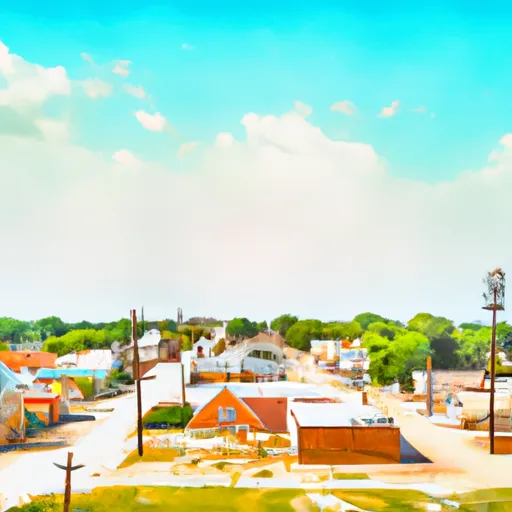-
 Snoflo Premium
Snoflo Premium
Get unlimited access to all our content
With no Ad interruptions! - Start Your Free Trial Login with existing account
Lequire
Eden Index
Climate
8.0
•
Recreation
1.4
•
Community
•
Safeguard
3.7/10

Lequire, Oklahoma is a small town located in the southeastern part of the state. The climate in Lequire is classified as humid subtropical, with hot summers and mild winters. Summers are characterized by high temperatures, reaching an average of around 90°F (32°C), while winters are relatively mild, with average temperatures around 50°F (10°C). The region experiences moderate rainfall throughout the year.
Hydrology constituents in Lequire are influenced by the presence of various creeks and rivers, including the Poteau River. These water sources provide opportunities for fishing, boating, and wildlife observation. The Poteau River is particularly popular for recreational activities such as kayaking and canoeing.
Outdoor recreation opportunities in Lequire abound. The town is surrounded by picturesque landscapes, offering opportunities for hiking, camping, and wildlife photography. The nearby Ouachita National Forest provides additional outdoor activities, including hunting, fishing, and horseback riding. Nature enthusiasts can explore the numerous trails and enjoy the scenic beauty of the area. Overall, Lequire offers a pleasant climate, diverse hydrology constituents, and ample outdoor recreation opportunities for visitors and residents alike.
What is the Eden Index?
The Snoflo Eden Index serves as a comprehensive rating system for regions, evaluating their desirability through a holistic assessment of climate health, outdoor recreation opportunities, and natural disaster risk, acknowledging the profound impact of these factors on livability and well-being.
Climate Health Indicator (CHI): 8.0
Lequire receives approximately
1258mm of rain per year,
with humidity levels near 85%
and air temperatures averaging around
16°C.
Lequire has a plant hardyness factor of
7, meaning
plants and agriculture in this region tend to thrive during the non-winter months.
By considering the ideal temperature range, reliable water supplies, clean air, and stable seasonal rain or snowpacks, the Climate Health Indicator (CHI) underscores the significance of a healthy climate as the foundation for quality living.
A healthy climate is paramount for ensuring a high quality of life and livability in a region, fostering both physical well-being and environmental harmony. This can be characterized by ideal temperatures, reliable access to water supplies, clean air, and consistent seasonal rain or snowpacks.
Weather Forecast
Streamflow Conditions
Robert S. Kerr Reservoir
Area Rivers
Robert S. Kerr Reservoir
Snowpack Depths
Robert S. Kerr Reservoir
Reservoir Storage Capacity
Robert S. Kerr Reservoir
Groundwater Levels
Recreational Opportunity Index (ROI): 1.4
The Recreational Opportunity Index (ROI) recognizes the value of outdoor recreational options, such as parks, hiking trails, camping sites, and fishing spots, while acknowledging that climate plays a pivotal role in ensuring the comfort and consistency of these experiences.
Access to outdoor recreational opportunities, encompassing activities such as parks, hiking, camping, and fishing, is crucial for overall well-being, and the climate plays a pivotal role in enabling and enhancing these experiences, ensuring that individuals can engage in nature-based activities comfortably and consistently.
Camping Areas
| Campground | Campsites | Reservations | Toilets | Showers | Elevation |
|---|---|---|---|---|---|
| Walleye Park - Lake Cypress Springs | 100 | 430 ft | |||
| Dogwood Park | None | 399 ft | |||
| Twin Oaks Park - Lake Cypress Springs | None | 387 ft | |||
| Raymond Gary State Park | None | 480 ft | |||
| Monticello Park - Monticello Reservoir | 28 | 389 ft | |||
| Titus County Park | None | 362 ft | |||
| Winnsboro City RV Park | 20 | 495 ft | |||
| Lake Bob Sandlin State Park | 95 | 415 ft | |||
| Jack Guthrie Park - Monticello Reservoir | None | 414 ft | |||
| Overlook Park - Lake Cypress Springs | None | 390 ft |
Nearby Fishing
Catastrophe Safeguard Index (CSI):
The Catastrophe Safeguard Index (CSI) recognizes that natural disaster risk, encompassing floods, fires, hurricanes, and tornadoes, can drastically affect safety and the overall appeal of an area.
The level of natural disaster risk in a region significantly affects safety and the overall livability, with climate change amplifying these risks by potentially increasing the frequency and intensity of events like floods, fires, hurricanes, and tornadoes, thereby posing substantial challenges to community resilience and well-being.
Community Resilience Indicator (CRI):
The Community Resilience Indicator (CRI) recognizes that education, healthcare, and socioeconomics are crucial to the well-being of a region. The CRI acknowledges the profound impact of these elements on residents' overall quality of life. By evaluating educational resources, healthcare accessibility, and economic inclusivity, the index captures the essential aspects that contribute to a thriving community, fostering resident satisfaction, equity, and social cohesion.

